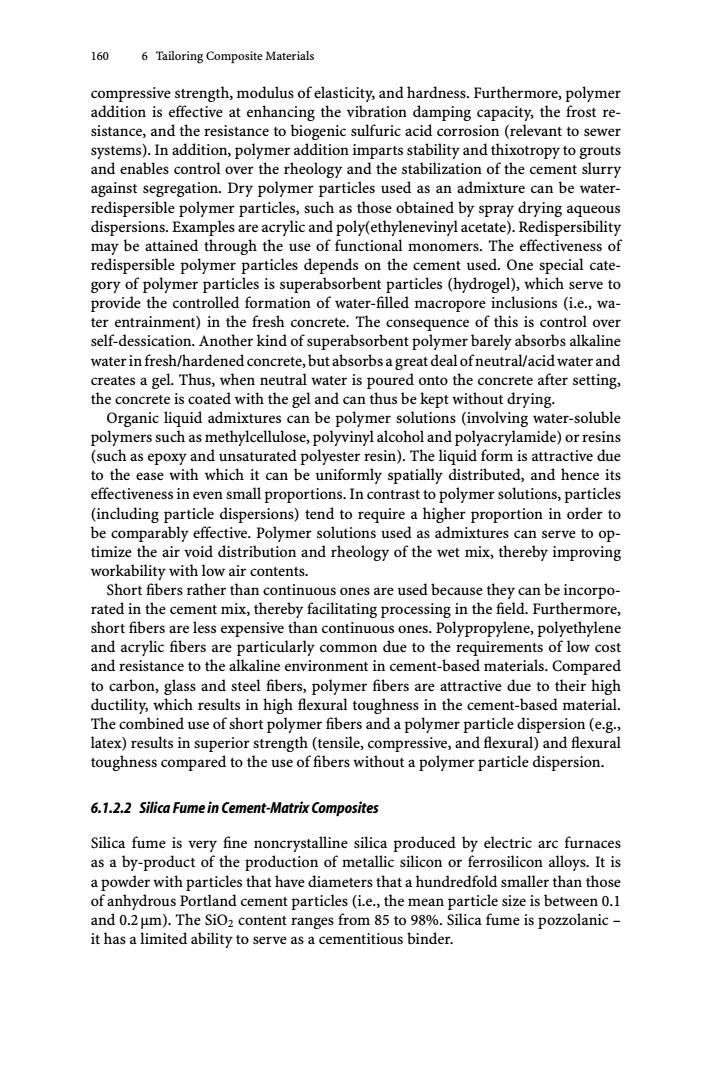正在加载图片...

160 6 Tailoring Composite Materials compressive strength,modulus of elasticity,and hardness.Furthermore,polymer addition is effective at enhancing the vibration damping capacity,the frost re- sistance,and the resistance to biogenic sulfuric acid corrosion(relevant to sewer systems).In addition,polymer addition imparts stability and thixotropy to grouts and enables control over the rheology and the stabilization of the cement slurry against segregation.Dry polymer particles used as an admixture can be water- redispersible polymer particles,such as those obtained by spray drying aqueous dispersions.Examples are acrylic and poly(ethylenevinyl acetate).Redispersibility may be attained through the use of functional monomers.The effectiveness of redispersible polymer particles depends on the cement used.One special cate- gory of polymer particles is superabsorbent particles (hydrogel),which serve to provide the controlled formation of water-filled macropore inclusions(i.e.,wa- ter entrainment)in the fresh concrete.The consequence of this is control over self-dessication.Another kind of superabsorbent polymer barely absorbs alkaline water in fresh/hardened concrete,but absorbs a great deal ofneutral/acid water and creates a gel.Thus,when neutral water is poured onto the concrete after setting, the concrete is coated with the gel and can thus be kept without drying. Organic liquid admixtures can be polymer solutions(involving water-soluble polymers such as methylcellulose,polyvinyl alcohol and polyacrylamide)or resins (such as epoxy and unsaturated polyester resin).The liquid form is attractive due to the ease with which it can be uniformly spatially distributed,and hence its effectiveness in even small proportions.In contrast to polymer solutions,particles (including particle dispersions)tend to require a higher proportion in order to be comparably effective.Polymer solutions used as admixtures can serve to op- timize the air void distribution and rheology of the wet mix,thereby improving workability with low air contents. Short fibers rather than continuous ones are used because they can be incorpo- rated in the cement mix,thereby facilitating processing in the field.Furthermore, short fibers are less expensive than continuous ones.Polypropylene,polyethylene and acrylic fibers are particularly common due to the requirements of low cost and resistance to the alkaline environment in cement-based materials.Compared to carbon,glass and steel fibers,polymer fibers are attractive due to their high ductility,which results in high flexural toughness in the cement-based material. The combined use of short polymer fibers and a polymer particle dispersion(e.g., latex)results in superior strength(tensile,compressive,and flexural)and flexural toughness compared to the use of fibers without a polymer particle dispersion. 6.1.2.2 Silica Fume in Cement-Matrix Composites Silica fume is very fine noncrystalline silica produced by electric arc furnaces as a by-product of the production of metallic silicon or ferrosilicon alloys.It is a powder with particles that have diameters that a hundredfold smaller than those of anhydrous Portland cement particles (i.e.,the mean particle size is between 0.1 and 0.2 um).The SiO2 content ranges from 85 to 98%.Silica fume is pozzolanic- it has a limited ability to serve as a cementitious binder.160 6 Tailoring Composite Materials compressive strength, modulus of elasticity, and hardness. Furthermore, polymer addition is effective at enhancing the vibration damping capacity, the frost resistance, and the resistance to biogenic sulfuric acid corrosion (relevant to sewer systems). In addition, polymer addition imparts stability and thixotropy to grouts and enables control over the rheology and the stabilization of the cement slurry against segregation. Dry polymer particles used as an admixture can be waterredispersible polymer particles, such as those obtained by spray drying aqueous dispersions. Examples are acrylic and poly(ethylenevinyl acetate). Redispersibility may be attained through the use of functional monomers. The effectiveness of redispersible polymer particles depends on the cement used. One special category of polymer particles is superabsorbent particles (hydrogel), which serve to provide the controlled formation of water-filled macropore inclusions (i.e., water entrainment) in the fresh concrete. The consequence of this is control over self-dessication. Another kind of superabsorbent polymer barely absorbs alkaline water in fresh/hardened concrete, but absorbs a great deal of neutral/acid water and creates a gel. Thus, when neutral water is poured onto the concrete after setting, the concrete is coated with the gel and can thus be kept without drying. Organic liquid admixtures can be polymer solutions (involving water-soluble polymers such as methylcellulose, polyvinyl alcohol and polyacrylamide) or resins (such as epoxy and unsaturated polyester resin). The liquid form is attractive due to the ease with which it can be uniformly spatially distributed, and hence its effectiveness in even small proportions. In contrast to polymer solutions, particles (including particle dispersions) tend to require a higher proportion in order to be comparably effective. Polymer solutions used as admixtures can serve to optimize the air void distribution and rheology of the wet mix, thereby improving workability with low air contents. Short fibers rather than continuous ones are used because they can be incorporated in the cement mix, thereby facilitating processing in the field. Furthermore, short fibers are less expensive than continuous ones. Polypropylene, polyethylene and acrylic fibers are particularly common due to the requirements of low cost and resistance to the alkaline environment in cement-based materials. Compared to carbon, glass and steel fibers, polymer fibers are attractive due to their high ductility, which results in high flexural toughness in the cement-based material. The combined use of short polymer fibers and a polymer particle dispersion (e.g., latex) results in superior strength (tensile, compressive, and flexural) and flexural toughness compared to the use of fibers without a polymer particle dispersion. 6.1.2.2 Silica Fume in Cement-Matrix Composites Silica fume is very fine noncrystalline silica produced by electric arc furnaces as a by-product of the production of metallic silicon or ferrosilicon alloys. It is a powder with particles that have diameters that a hundredfold smaller than those of anhydrous Portland cement particles (i.e., the mean particle size is between 0.1 and 0.2μm). The SiO2 content ranges from 85 to 98%. Silica fume is pozzolanic – it has a limited ability to serve as a cementitious binder